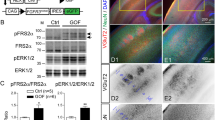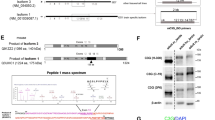Abstract
Migration of neurons from proliferative zones to their functional sites is fundamental to the normal development of the central nervous system1,2. Mice homozygous for the spontaneous rostral cerebellar malformation mutation (rcms) or a newly identified transgenic insertion allele (rcmtg) exhibit cerebellar and midbrain defects, apparently as a result of abnormal neuronal migration. Laminar structure abnormalities in lateral regions of the rostral cerebellar cortex have been described in homozygous rcms mice3. We now demonstrate that the cerebellum of both rcms and rcmtg homozygotes is smaller and has fewer folia than in the wild-type, ectopic cerebellar cells are present in midbrain regions by three days after birth, and there are abnormalities in postnatal cerebellar neuronal migration. We have cloned the rcm complementary DNA, which encodes a transmembrane receptor of the immunoglobulin superfamily. The sequence of the rcm protein (Rcm) is highly similar to that of UNC-5, a Caenorhabditis elegans protein that is essential for dorsal guidance of pioneer axons and for the movement of cells away from the netrin ligand, which is encoded by the unc-6 gene4–7. As Rcm is a member of a newly described family of vertebrate homologues of UNC-5 which are netrin-binding proteins, our results indicate that UNC-5-like proteins may have a conserved function in mediating netrin-guided migration8.
This is a preview of subscription content, access via your institution
Access options
Subscribe to this journal
Receive 51 print issues and online access
$199.00 per year
only $3.90 per issue
Buy this article
- Purchase on Springer Link
- Instant access to full article PDF
Prices may be subject to local taxes which are calculated during checkout
Similar content being viewed by others
References
Cowan, W. M. Development in the Nervous System (Cambridge University Press, London, 1981).
Hatten, M. E. & Heintz, N. Mechanisms of neural patterning and specification in the developing cerebellum. Annu. Rev. Neurosci. 18, 385–408 (1995).
Lane, P. W., Bronson, R. T. & Spencer, C. A. Rostral cerebellar malformation (rcm): A new recessive mutation on chromosome 3 of the mouse. J. Hered. 83, 315–318 (1992).
Hedgecock, E. M., Culotti, J. G. & Hall, D. H. The unc-5, unc-6, and unc-40 genes guide circumferential migrations of pioneer axons and mesodermal cells on the epidermis in C. elegans. Neuron 4, 61–85 (1990).
Leung-Hagesteijn, C. et al. UNC-5, a transmembrane protein with immunoglobulin and thrombo-spondin type 1 domains, guides cell and pioneer axon migrations in C. elegans. Cell 71, 289–299 (1992).
Hamelin, M., Zhou, Y., Su, M.-W., Scott, I. M. & Culotti, J. G. Expression of the UNC-5 guidance receptor in the touch neurons of C. elegans steers their axons dorsally. Nature 364, 327–330 (1993).
Wadsworth, W. G., Bhatt, H. & Hedgecock, E. M. Neuroglia and pioneer neurons express UNC-6 to provide global and local netrin cues for guiding migrations in C. elegans. Neuron 16, 36–46 (1996).
Leonardo, E. D. et al. Vertebrate homologues of C. elegans UNC-5 are candidate netrin receptors. Nature 386, 833–838 (1997).
Akazawa, C. et al. A mammalian helix-loop-helix factor structurally related to the produce of Drosophila proneural gene atonal is a positive transcriptional regulator expressed in the developing nervous system. J. Biol. Chem. 270, 8730–8738 (1995).
Ben-Arie, N. et al. Evolutionary conservation of sequence and expression of the bHLH protein Atonal suggests a conserved role in neurogenesis. Hum. Mol. Gen. 4, 1207–1216 (1996).
Johnson, K. R., Cook, S. A. & Davisson, M. T. Chromosomal localization of the murine gene and two related sequences encoding high-mobility-group 1 and Y proteins. Genomics 12, 503–509 (1992).
Willott, E. et al. The tight junction protein ZO-1 is homologous to the Drosophila discs-large tumor suppressor protein of septate junctions. Proc. Natl Acad. Sci. USA 90, 7834–7838 (1993).
Serafini, T. et al. The netrins define a family of azon outgrowth-promoting proteins homologous to C. elegans. UNC-6. Cell 78, 409–424 (1994).
Serafini, T. et al. Netrin-1 is required for commissural axon guidance in the developing vertebrate nervous system. Cell 87, 1001–1014 (1996).
Livesey, F. J. & Hunt, S. P. Netrin and netrin receptor expression in the embryonic mammalian nervous system suggests roles in retinal, striatal, nigral and cerebellar development. Mol. Cell. Neurosci. (in the press).
Boyer, B. B. & Kozak, L. P. The mitochondrial uncoupling protein gene in brown fat: Correlation between DNase I hypersensitivity and expression in transgenic mice. Mol. Cell. Biol. 11, 4147–4156 (1991).
Sternberg, N., Smoller, D. & Braden, T. Three new developments in PI cloning. Increased cloning efficiency, improved clone recovery, and a new PI mouse library. Genet. Analyt. Tech. Appl. 11, 171–80 (1994).
Chomzynski, P. & Sacchi, N. Single-step method of RNA isolation by acid guanidinium thiocyanate-phenol-chloroform extraction. Analyt. Biochem. 162, 156–159 (1987).
Sambrook, J., Fritsch, E. F. & Maniatis, T. Molecular Cloning: A Laboratory Manual (Cold Spring Harbor Laboratory Press, Cold Spring Harbor, New York, 1989).
Hui, C.-C. & Joyner, A. L. A mouse model of Greig cephalo-polysyndactyly syndrome: the extra-toes j mutation contains an intragenic deletion of the Gli3 gene. Nature Genet. 3, 241–245 (1993).
Kyte, J. & Doolittle, R. F. A simple method for displaying the hydropathic character of a protein. J. Mol. Biol. 157, 105–132 (1982).
von Heijne, G. A new method for predicting signal sequence cleavage sites. Nucleic Acids Res. 14, 4683–4690 (1986).
Klein, P., Kanehisa, M. & Delisi, C. The detection and classification of membrane-spanning proteins. Biochim. Biophys. Acta. 815, 468–476 (1985).
Singer, S. F. The structure and insertion of integral proteins in membranes. Annu. Rev. Cell Biol. 6, 247–296 (1990).
Author information
Authors and Affiliations
Rights and permissions
About this article
Cite this article
Ackerman, S., Kozak, L., Przyborski, S. et al. The mouse rostral cerebellar malformation gene encodes an UNC-5-like protein. Nature 386, 838–842 (1997). https://doi.org/10.1038/386838a0
Received:
Accepted:
Issue Date:
DOI: https://doi.org/10.1038/386838a0
This article is cited by
-
A Circular RNA Expressed from the FAT3 Locus Regulates Neural Development
Molecular Neurobiology (2023)
-
Uncoordinated protein coordinates cell migration
Nature (2022)
-
Commissural axon guidance in the developing spinal cord: from Cajal to the present day
Neural Development (2019)
-
Reduced gene expression of netrin family members in skin and sural nerve specimens of patients with painful peripheral neuropathies
Journal of Neurology (2019)
Comments
By submitting a comment you agree to abide by our Terms and Community Guidelines. If you find something abusive or that does not comply with our terms or guidelines please flag it as inappropriate.



